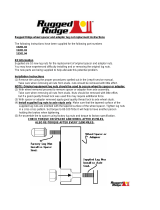
Rev. C
ProForce Debris BlowerPage 1 -- 4Safety
Maintenance and Service
1. Before servicing or making adjustments to ProForce
Debris Blower, position ProForce Debris Blower on a
level surface and stop blower engine. If blower is at-
tached to tow vehicle, apply tow vehicle parking brake,
stop engine and remove key from the ignition switch.
Also, turn blower ignition switch OFF and remove key
from switch.
2. To prevent unexpected machine operation, discon-
nect battery before performing any Debris Blower ser-
vice. Disconnect negative battery cable first and
positive cable last. If battery voltage is required for trou-
bleshooting or test procedures, temporarily connect the
battery. Reconnect positive battery cable first and nega-
tive cable last.
3. Make sure machine is in safe operating condition by
keeping all nuts, bolts, screws and other fasteners tight.
4. Use care when checking or servicing the blower:
wear gloves and use caution.
5. Before disconnecting ProForce Debris Blower from
tow vehicle, park blower on a hard, level surface and
chock blower wheels to prevent machine movement.
6. To reduce potential fire hazard, keep engine area
free of excessive grease, grass, leaves and dirt.
7. If engine must be running to perform maintenance or
to make an adjustment, keep hands, feet, clothing and
other parts of the body away from moving parts on the
Debris Blower . Keep bystanders away.
8. Do not overspeed the engine by changing governor
setting. To assure safety and accuracy, check maximum
engine speed with a tachometer.
9. Shut Debris Blower engine off before checking or
adding oil to the crankcase.
10.Battery acid is poisonous and can cause burns.
Avoid contact with skin, eyes and clothing. Protect your
face, eyes and clothing when working with a battery.
11. Battery gases can explode. Keep cigarettes, sparks
and flames away from the battery.
12.After servicing the ProForce Debris Blower , be sure
that all guards and covers are properly installed.
13.When changing tires or performing other service,
use correct supports, hoists and jacks. Make sure ma-
chine is parked on a solid level surface such as a con-
crete floor. Always chock or block wheels. Use suitable
jack stands to support the raised machine. If the ma-
chine is not properly supported by suitable jack stands,
the machine may move or fall, which may result in per-
sonal injury (see Jacking Instructions in this chapter).
14.If welding on the machine is necessary, disconnect
the negative battery cable and the wire harness con-
nector from the wireless control module to prevent elec-
trical system damage.
15.If major repairs are ever needed or assistance is de-
sired, contact an Authorized Toro Distributor.
16.Engine oil, engine and remote batteries are pollut-
ants to the environment. Dispose of these according to
your state and local regulations.
17.At the time of manufacture, the machine conformed
to all applicable safety standards. To assure optimum
performance and continued safety certification of the
machine, use genuine Toro replacement parts and ac-
cessories. Replacement parts and accessories made
by other manufacturers may result in non-conformance
with the safety standards, and the warranty may be
voided.





















